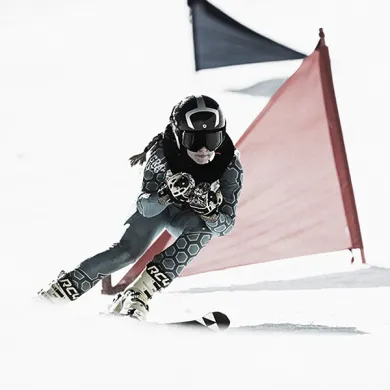There are many different kinds of skiing, from casual skiing at a ski resort to competitive skiing on a professional course. Even within the world of competitive skiing, there are various different disciplines and one of them is slalom skiing. In this guide to skiing slalom rules, we’ll go over all you need to know about the slalom ski course and all the different rules of slalom skiing.

What is slalom skiing?
Before we get into the rules of slalom skiing, let’s first explain what exactly it is all about. Put simply, slalom skiing is the type of skiing wherein riders must navigate their descent down a slope through slalom skiing gates or poles.
When we refer to slalom skiing gates or poles, these are essentially the same thing, since the two poles make up the gates. Competitors must pass in between the various gates on their way down a slope as they try to set the fastest time, with the main slalom skiing rules being that missing a gate brings about disqualification.
What are the rules of slalom skiing?
Moving on to the specific skiing slalom rules, these can differ slightly depending on where and when you are competing. The highest form of competition in this skiing discipline is the Winter Olympics, although many other slalom skiing events are held every year such as the Alpine Ski World Cup Finals. This has previously been held on the slopes of Grandvalira in Andorra.
According to the IOC, the rules of slalom skiing are: “In slalom skiing, competitors ski down a slope that has a vertical descent of 180m to 220m for men or 140m to 180m for women. Skiers pass through gates or two plastic poles. Each gate has a minimum width of 4m and a maximum of 6m. Skiers often knock over the poles in order to find the fastest route. Slalom skiers have to pass through two courses. Eliminations take place after the first course based on timings. The competitor with the lowest combined time across the two courses is declared the winner.”
The slalom skiing gates are set out in such a way that the hardest turns are saved for the middle of the course. The organisers don’t like to put them near the start, when a rider doesn’t yet have much speed, or near the end, when a rider wants to carry as much speed as possible over the finish line. As for how do slalom skiers know which gates to go through next, they are set out alternately in red and blue to help with identification.
Many people wonder ‘Why do slalom skiers hit the gates?’, and the simple reason for this is that it’s quicker to do so, rather than completely avoid them. And touching the gates is permitted in the slalom skiing rules.
Finally, at official Olympic events, the riders have to navigate two different runs and their times are added up. Those who set slalom skiing rules advise that both runs should be completed on the same day.
Skiing slalom rules: What is the difference between slalom vs giant slalom?
Giant slalom is almost the same but, as the name suggests, it’s a bit bigger. The length of the slope is longer and the width of the gates is wider. Specifically, the giant slalom skiing rules state that the vertical descent must be between 250m to 450m for men and 250m to 400m for women, while the gates have to have a minimum width of 4m and a maximum width of 8m.
In terms of the rest of the giant slalom skiing rules, these are very similar to the rules of slalom skiing. You can’t miss any gates and your times across both runs are added up.
